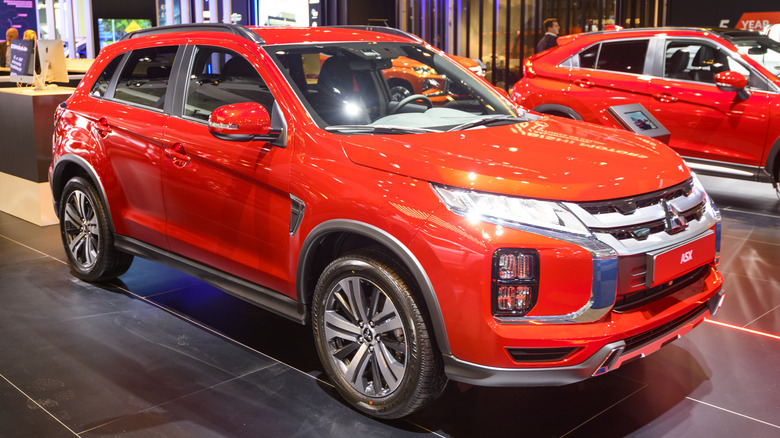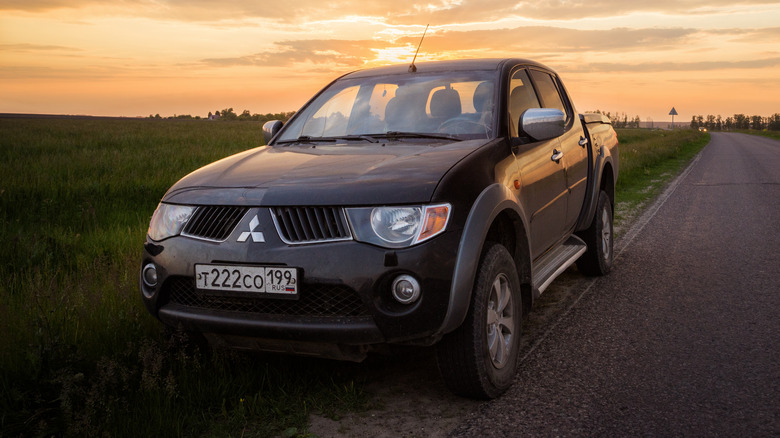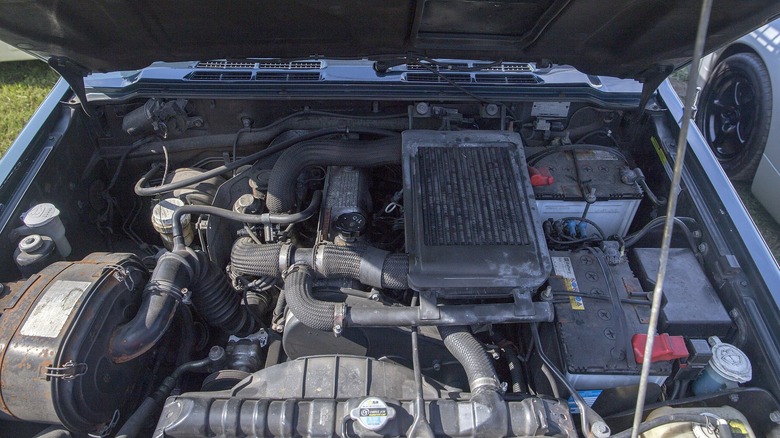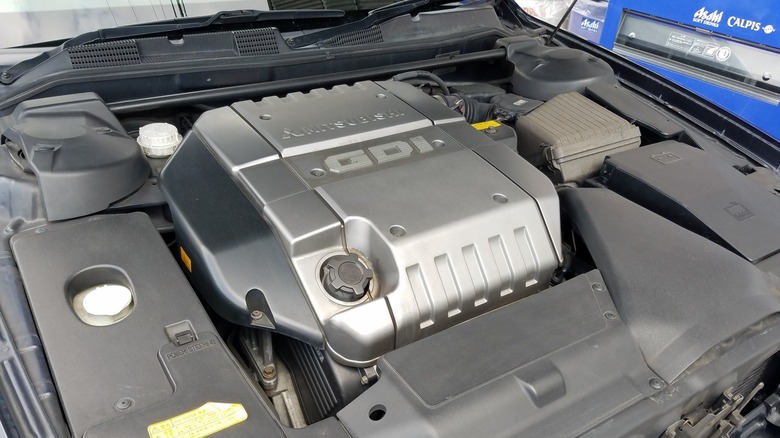
Tramino/Getty Images
Mitsubishi can trace its car manufacturing history back over 100 years, but it first made a name for itself on the global stage in postwar Japan. Like all Japanese manufacturers, Mitsubishi’s chief appeal was that its cars were both affordable and reliable, undercutting what many foreign rivals could offer while beating them on longevity. It’s a reputation that Mitsubishi has carried through to this day, with its SUVs, pickups, and commercial trucks still favorites with buyers all over the globe.
The engines of Mitsubishi vehicles are, in general, a safe bet, with many racking up hundreds of thousands of miles of service with minimal issues. However, a few stand out from the rest, either because they’ve proved to be better than other rivals in their segment or because they’re simply tough enough to withstand whatever a driver can throw at them. Often, it’s a mix of both. Many of Mitsubishi’s most popular models would not have had the same impact had they not featured these 10 reliable mills under the hood.
Mitsubishi 4N14

Sjoerd Van Der Wal/Getty Images
Mitsubishi’s diesel engines have a reputation for being able to withstand years of hard use, and the 4N14 lives up to that reputation. It won’t win any awards for performance — in fact, in most applications, it’s exactly the opposite — but it remains relatively efficient as well as being dependable. The four-cylinder engine has featured in Mitsubishi’s ASX crossover for the past decade and has been available in the current generation Delica minivan in Japan. It’s also available in the Outlander SUV in territories where diesel is still in demand (so, not in the U.S.).
The Delica is the most unique vehicle where the 4N14 can be found since it’s now in its fifth generation and still features the same off-road capabilities that made previous generations a cult classic both in its home territory and abroad. It’s a shame that Mitsubishi has never offered the car Stateside — after all, America essentially invented the minivan segment with the launch of the Dodge Caravan/Plymouth Voyager, and the current market proves that off-road capabilities are still a desirable feature for many drivers. Nonetheless, the Delica remains a forbidden fruit for now, as does the 4N14 under its hood.
Mitsubishi 4G94

Smlive903/Wikipedia
One of the largest variants of the 4G family, the 4G94, was used in a variety of Mitsubishi models throughout the ’00s. The 2.0L four-cylinder made up to 144 horsepower in its most powerful form and was available in models including the Lancer, Galant, and Montero/Pajero. A good indicator of whether an engine is reliable is whether the design is snapped up by another manufacturer after production by the original manufacturer ends; the 4G94 was one such engine. It enjoyed a second life after its original Mitsubishi production run, with Chinese carmaker Hawtai continuing to produce it until 2015.
Like many of Mitsubishi’s most reliable engines, it’s by no means a performance powerhouse. In fact, it’s less powerful than many similarly sized engines from rivals, but with some aftermarket assistance, it’s possible to increase its output by a significant amount. However, for engine longevity, that’s not recommended — keeping it stock and properly maintained, of course, is the key to making the most of this everyday workhorse mill.
[Featured image by Smlive903 via Wikimedia Commons | Cropped and scaled | CC BY-SA 3.0]
Mitsubishi 4G69

Visva0224/Wikipedia
One factor in determining engine reliability is how long it’s been in production. The longer it’s been around, the more time the manufacturer will have had to sort out any weak points and tweak the design if need be. The Mitsubishi 4G69 has been in production since 2003 and is still being used today in various forms. It was produced by Mitsubishi until 2012, featuring in the likes of the Galant, the Lancer, and the Eclipse. When it’s looked after correctly, owners reported getting up to 300,000 miles out of the engine, often with other parts of the car failing before the engine ever gave out.
Tightening emissions, changing design requirements, and the arrival of a new generation of engines meant that the 4G69 was eventually retired by Mitsubishi. But it continues to feature in a range of Chinese-manufactured cars and vans. As the world’s largest car market, Chinese consumers have a wider range of models to choose from than any other territory. So, it’s telling that there are still multiple new Chinese cars and trucks out there with this now 20-year-old engine. Among others, Great Wall, Maxus, and CMC Mitusbishi (a Chinese Mitsubishi joint venture) all currently produce vehicles sporting the 4G69.
[Featured image by Visva0224 via Wikimedia Commons | Cropped and scaled | Public Domain]
Mitsubishi 6B31

Heritage Images/Getty Images
The 6B31 has only been installed on two Mitsubishi models: the Outlander and the Pajero Sport. It first appeared in the Outlander in 2006 and in the Pajero Sport in 2010. It remains in production in both cars today in certain markets. Its stock power is relatively modest, but thanks to its solid build quality, it’s a good candidate for upgrades. However, it should be noted that performance-boosting aftermarket parts often run the risk of decreasing reliability in the long run.
The engine isn’t without its flaws — there have been reports of oil leaks and carbon buildup, but like all engines, regular and comprehensive maintenance should prevent issues in most cases. Its 3.0-liter displacement also means it’s not as fuel-sipping as some of its rivals, but most owners are willing to take the hit for the extra reliability. Like many of Mitsubishi’s best engines, the 6B31 is not available to buy for U.S. customers, as the USDM Outlander’s sole engine configuration for 2024 is a smaller 2.5L four-cylinder.
Mitsubishi 4G64

Everyonephoto Studio/Shutterstock
Another long-running Mitsubishi engine is the 4G64, a 2.4-liter four-cylinder that’s been around since 1985. It has appeared in everything from the Outlander and L200 to the ’97-’05 Eclipse, sporting an output of 165 horsepower in its most potent form. It was also built under license by Hyundai between 1998 and 2006, with the designation G4JS. In addition, Mitsubishi’s partnership with Chrysler saw it appear in a range of Plymouth, Dodge, and Eagle cars, making parts easy to find and affordable in case anything goes wrong.
Average lifespans varied between models, but in general, racking up more than 200,000 miles was achievable with proper maintenance. The engine is closely related to the 4G63, which is also considered one of the brand’s best engines ever made, with the primary difference being displacement. The 4G64 is the larger of the two by around 400cc. Much like its smaller counterpart, the engine is ripe for upgrading, and plenty of advice is available on owners’ forums for anyone thinking of taking on such a project.
Mitsubishi 6G72

PistonPL/Wikipedia
Mitsubishi has been making six-cylinder engines since the ’60s, and the 6G72 is considered to be among the best of them. It boasts an impressively long production run, with the first examples appearing in 1986 and production continuing until 2008. During that period, it appeared in many of Mitsubishi’s best-selling models, including the Pajero/Montero, the Delica 4, and the L200 pickup truck. It also appeared in several Chrysler and Dodge models thanks to the American automaker’s partnership with Mitsubishi at the time.
The first three generations of the Dodge Caravan all featured the 3.0-liter V6, along with the Chrysler New Yorker and Town & Country. Engine lifespans over 250,000 miles are not uncommon, assuming maintenance is kept up to date. Alongside Chrysler, Hyundai also had a longstanding partnership with Mitsubishi and produced a licensed version of the 6G72 called the G6AT throughout the ’90s and into the early ’00s. The engine appeared in both the Hyundai Galloper SUV and the Sonata sedan.
[Featured image by PistonPL via Wikimedia Commons | Cropped and scaled | Public Domain]
Mitsubishi 4M41

Nikolai Denisov/Shutterstock
The 4M41 was developed as a larger variant of the 4M40 while fixing a few of the gremlins its stablemate suffered from. Displacement was increased from 2.8-liter up to 3.2-liter, all while improving emissions to comply with regulations both in Japan and export markets. Fuel consumption was also reduced by around 25% compared to its predecessor, according to Mitsubishi.
It was primarily used in the Pajero and L200, both of which were expected by owners to rack up high mileage without issue. The 4M41 delivered on that promise, with an estimated lifespan of more than 250,000 miles.
Various tweaks have been made to the engine in the years it’s been in production, with newer variants sporting a 200 horsepower output, a considerable improvement over the 165 horses available from earlier versions. These later versions are also generally the most reliable and worth paying a premium for on the used market.
Mitsubishi 4D56

Mr.choppers/Wikipedia
One of Mitsubishi’s most reliable diesel engines is the 2.5-liter 4D56, which has been featured in the Delica, L200, and Pajero. Owners peg its expected lifespan at more than 300,000 miles before needing significant work, although, like any engine, this will vary from vehicle to vehicle and largely depend on the maintenance and type of driving done by previous owners. And there may well be a list of previous owners — the oldest vehicles with the engine rolled off the production line in the mid-’80s.
The 4D56 remained in production until 2016 when it was retired in favor of more efficient, powerful engines. However, its relatively modest power as standard can be easily improved upon, as there is a solid aftermarket and plenty of enthusiasts on owners’ forums with experience in extracting more ponies out of this workhorse powerplant. Alongside its appearance in Mitsubishi vehicles, the 4D56 was also adapted by Hyundai for use in a range of its vehicles between 1991 and 2007.
[Featured image by Mr.choppers via Wikimedia Commons | Cropped and scaled | CC BY-SA 3.0]
Mitsubishi 6G74

Toyotacoronaexsaloon/Wikipedia
If four cylinders aren’t enough, then another of Mitsubishi’s top engines is the 6G74. Over its long lifespan, several improvements were made by the manufacturer, including improving its fuel economy and power output. It appeared in a range of Mitsubishi models but is perhaps best known for its appearance in the Pajero/Montero and L200. Like many of the Japanese automaker’s best engines, Hyundai also built it under license for use in a range of SUVs and sedans, albeit with a slightly lower expected lifespan.
Owner reports are, in general, glowing for the engine. Its application in the Pajero and L200 means that towing and off-road driving are common requirements, and it’s known to handle both with aplomb. It’ll take plenty of punishment, but buyers of used examples should be aware that these engines aren’t indestructible. Nonetheless, on the rare occasion they do break, they’re usually affordable and straightforward to fix.
[Featured image by Toyotacoronaexsaloon via Wikimedia Commons | Cropped and scaled | CC BY-SA 4.0]
Mitsubishi 4G63T

Txus Lopez/Shutterstock
The 4G63T is regarded as one of the best four-cylinders of its kind, mostly thanks to its role in powering nine different generations of the brand’s iconic Lancer Evolution. The non-turbo 4G63 had been around since the start of the ’80s, and the 4G63T was initially developed so Mitsubishi could enter the World Rally Championship. It debuted in the Galant VR-4 with mixed results but really hit its prime when the automaker pivoted its WRC efforts to the Lancer in 1992.
The Lancer proved to be a dominant force, winning a string of drivers’ titles with Tommi Mäkinen behind the wheel, along with the manufacturers’ title in ’98. The customer version of the 4G63T was very similar to its racing counterpart, which meant it proved to be bulletproof even when owners pushed it to its limits.
It also proved it could handle huge amounts of extra power, making the Evo Lancer a tuners’ favorite and leading Mitsubishi to eventually release factory-backed versions with higher power outputs, like the UK-only FQ-400. Today, you can find builds making over double their stock output while still remaining reliable.










